Boot Hill
Boot Hill, or Boothill, is the given name of many cemeteries, chiefly in the Western United States. During the 19th and early 20th century it was a common name for the burial grounds of gunfighters, or those who "died with their boots on" (i.e., violently).
.jpg.webp)
Origin of term
Although many towns use the name "Boot Hill," the first graveyard named "Boot Hill" was at Hays, Kansas, 5 years before the founding of Dodge City, Kansas.[1] The term alludes to the fact that many of its occupants were cowboys who "died with their boots on," the implication here being they died violently, as in gunfights or by hanging, and not of natural causes. The term became commonplace throughout the Old West, with some Boot Hills becoming famous, such as Dodge City, Kansas, Tombstone, Arizona, and Deadwood, South Dakota.
Boothill Graveyard
The most notable use of the name "Boot Hill" is at the Boothill Graveyard in Tombstone, Arizona. 31°43′11.6″N 110°04′13.6″W Formerly called the "Tombstone Cemetery", the plot features the graves of Billy Clanton, Frank McLaury and Tom McLaury; the three men who were killed during the famed Gunfight at the O.K. Corral.[2]
Located on the northwest corner of the town, the graveyard is believed to hold over 300 persons, 205 of which are recorded. This was due to some people (especially Chinese and Jewish immigrants) being buried without record. There is a separate Jewish cemetery nearby with some markers restored, and there are also marked graves of Chinese. However, most of the loss was due to neglect of grave markers and theft of these wooden relics as souvenirs.[3] For example, when former Tombstone Mayor John Clum visited Tombstone for the first Helldorado celebration in 1929, he was unable to locate the grave of his wife Mary, who had been buried in Boothill.
The Tombstone "boothill" cemetery was closed in late 1886, as the new "City Cemetery" on Allen Street opened. Thereafter, Boothill was referred to as the "old city cemetery" and neglected. It was used after that only to bury a few later outlaws (some legally hanged and one shot in a robbery), as well as a few colorful Western characters and one man (Emmett Crook Nunnally) who had spent many volunteer hours restoring it.[4]
Currently, the Boothill Graveyard is open to the public for a $5 fee, and is a popular stop for tourists visiting Tombstone.
Boot Hill Museum
.jpg.webp)
The Boot Hill Museum is located on the original location of the Boot Hill Cemetery in Dodge City, Kansas.[5]
In popular culture
Boot Hill is the name of the cemetery in Dodge City in the Gunsmoke radio series. In many episodes, the marshal (Matt Dillon) would allude to "putting you in Boot Hill", or "another man headed to Boot Hill". In the first season of the Gunsmoke television series, the introduction to each episode showed Matt Dillon walking around Boot Hill reflecting on the deaths of men buried there.
Boot Hill cemetery is a main plot point in the Twilight Zone episode Mr. Garrity and the Graves.
Boothill Graveyards are referenced in many films such as Tombstone (1993), Wyatt Earp (1994), The Magnificent Seven (1960) and Gunfight at the O.K. Corral (1957), during which it was repeatedly sung over the recurring title theme song by Frankie Laine.[6] In the later half of the movie Laine changes the theme to:
Boothill... Boothill...
So cold... so still...
There they lay side by side,
the killers that died,in the Gunfight at O.K. Corral.
Boot Hill is the name of a role playing game first published in 1975 by TSR, Inc., the original publisher of Dungeons & Dragons. It was the third game released by TSR and notable as one of the first games to use ten-sided dice.
Boot Hill also appears in the first-person shooter video game Borderlands 2, located in 'The Dust', and playing home to a 'truxican standoff'.
Carl Perkins wrote in 1959 a song "The Ballad of Boot Hill". Johnny Cash recorded it for Columbia Records and it was released in the same year.[7]
A Spaghetti Western named Boot Hill was released in 1969 and it featured Terence Hill and Bud Spencer.[8]
The first of three parts that compose the Neil Young song "Country Girl", that appears in his 1970 album with Crosby, Stills & Nash, "Déjà Vu", is called "Whiskey Boot Hill".
The Outlaws' song "Hurry Sundown" also references "lying" an unnamed character in "Boot Hill".
Several themes from Bob Dylan’s soundtrack album "Pat Garrett and Billy The Kid" (1973) contain the verse "Up to Boot Hill they'd like to send ya".
The song "The Ballad of Billy the Kid" from Billy Joel's 1973 Album Piano Man contains the lyrics "And he never had a sweetheart, but he finally found a home, underneath the boothill grave that bears his name".
"Boot Hill" (unknown) is the first track on Stevie Ray Vaughan's 1991 posthumous release The Sky is Crying. It was recorded in early 1989 and is one of the last fully produced songs completed prior to his untimely death in 1990.
In cricket, the term 'Boot Hill' is used to refer to the fielding position of short-leg because of its proximity to the batsman and high likelihood of being hit by the ball, making the position particularly dangerous. Players fielding in this position typically wear a helmet and other protection.
In the comic book series Preacher, the Saint of Killers rests at a tomb on Boot Hill when not actively pursuing his goals.
Boot Hill Cemetery is the name of the graveyard at Phantom Manor in Disneyland Paris.
In season 5 episode 16 of the animated series SpongeBob SquarePants, "Pest of the West", the character Spongebuck is told the old sheriff of Dead-Eye Gulch is at Boot Hill.
Gallery
Tombstone, Arizona
 The entrance to Boothill Graveyard
The entrance to Boothill Graveyard
31.720000°N 110.070278°W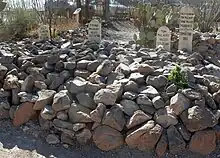 Graves of Billy Clanton and the McLaury brothers
Graves of Billy Clanton and the McLaury brothers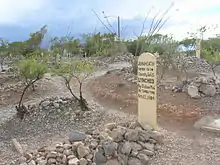 Alleged grave of John Wesley Heath
Alleged grave of John Wesley Heath Grave of George Johnson
Grave of George Johnson Grave of "Two Chinese"
Grave of "Two Chinese"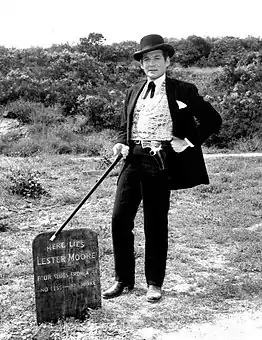 Gene Barry as Bat Masterson standing next to Lester Moore's grave in 1960
Gene Barry as Bat Masterson standing next to Lester Moore's grave in 1960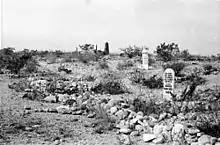 The Boothill Graveyard in 1940
The Boothill Graveyard in 1940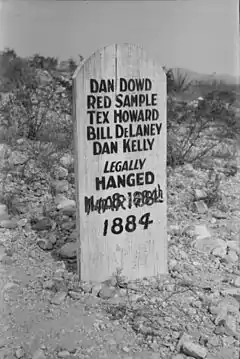 Graves of Dan Dowd, Red Sample, Tex Howard, Bill Delaney and Dan Kelly in 1940
Graves of Dan Dowd, Red Sample, Tex Howard, Bill Delaney and Dan Kelly in 1940 A blooming prickly pear at Boothill Graveyard
A blooming prickly pear at Boothill Graveyard
Deadwood, South Dakota
 Deadwood's Boot Hill, the Mount Moriah Cemetery
Deadwood's Boot Hill, the Mount Moriah Cemetery Plaques for Wild Bill Hickok and Calamity Jane
Plaques for Wild Bill Hickok and Calamity Jane Grave of Wild Bill Hickok
Grave of Wild Bill Hickok Bust of Wild Bill Hickok in 1891
Bust of Wild Bill Hickok in 1891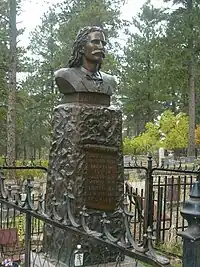 Bust of Wild Bill Hickok
Bust of Wild Bill Hickok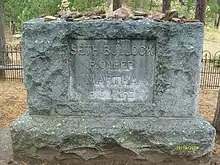 Grave of Seth Bullock and his wife Martha
Grave of Seth Bullock and his wife Martha
Dodge City, Kansas
.jpg.webp) The entrance to the Boot Hill Museum
The entrance to the Boot Hill Museum The shops at Boot Hill Museum, including a reconstruction of the Long Branch Saloon
The shops at Boot Hill Museum, including a reconstruction of the Long Branch Saloon.jpg.webp) Graves at the Boot Hill Cemetery in 1959
Graves at the Boot Hill Cemetery in 1959.jpg.webp) Graves and the Hangman's Tree
Graves and the Hangman's Tree The Hangman's Tree
The Hangman's Tree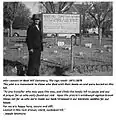 John M Lawson at Boot Hill Cemetery
John M Lawson at Boot Hill Cemetery
Miscellaneous
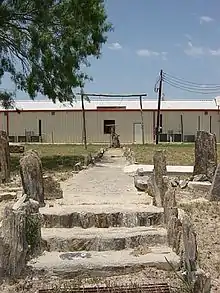 The Boot Hill Cemetery at Tilden, Texas in 2006
The Boot Hill Cemetery at Tilden, Texas in 2006 Historical marker in front of the Tilden Boot Hill Cemetery
Historical marker in front of the Tilden Boot Hill Cemetery Soapy Smith's grave at the Skagway, Alaska, Boot Hill
Soapy Smith's grave at the Skagway, Alaska, Boot Hill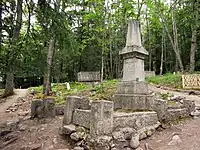 Grave of Frank H. Reid in Skagway
Grave of Frank H. Reid in Skagway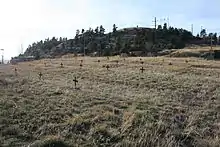 The Boothill Cemetery at Coulson, Montana
The Boothill Cemetery at Coulson, Montana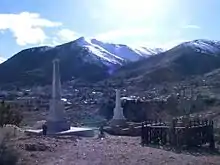 View of Virginia City, Nevada, from Boot Hill
View of Virginia City, Nevada, from Boot Hill
List of places with Boot Hill cemeteries
- Alma, New Mexico
- Anamosa, Iowa
- Billings, Montana[9]
- Bodie, California
- Bonanza, Idaho
- Calabasas, Santa Cruz County, Arizona[10]
- Calico, San Bernardino County, California
- Canyon City, Oregon
- Canyon Diablo, Arizona
- Columbia, California
- Coulson, Montana
- Cripple Creek, Colorado
- Deadwood, South Dakota
- Dodge City, Kansas
- El Paso, Texas
- Fort Sill, Oklahoma[11]
- Guthrie, Oklahoma
- Hartville, Wyoming[12]
- Hays, Kansas
- Idaho City, Idaho
- Leadville, Colorado
- Livermore, California
- Mowry, Arizona[13]
- Newton, Kansas
- Ogallala, Nebraska
- Pioche, Nevada
- Powderville, Montana
- Riley Camp, Quay County, New Mexico
- Seney Township, Michigan
- Sidney, Nebraska[14]
- Silver Reef, Utah
- Skagway, Alaska[15]
- Tascosa, Texas
- Tilden, Texas
- Tincup, Colorado[16]
- Tombstone, Arizona
- Valentine, Nebraska, also known as Minnechaduza Cemetery
- Virginia City, Montana
- Virginia City, Nevada
- Weaver, Arizona[17]
- Webster, Park County, Colorado[18]
- Prison graveyard at New Westminster, British Columbia.[19]
- Cemetery name given by the prisoners at the Japanese-run Batu Lintang POW and civilian internment camp in Kuching, Sarawak, Borneo during World War II.
- Fictional cemetery at the end of Phantom Manor at Disneyland Paris.
See also
References
- "Boot Hill Cemetery". The Milwaukee Journal. January 10, 1939. Retrieved July 1, 2014.
- Martin, Douglas D. (1997). Tombstone's Epitaph. University of Oklahoma Press. ISBN 978-0806129822.
- Interment Cemetery Records. Retrieved 2010-03-11.
- Ben T. Traywick, Tombstone's Boothill, Red Marie's Bookstore, Tombstone AZ, 1971.
- "Boot Hill Museum and Front Street". Boot Hill Cemetery. Archived from the original on 28 August 2011. Retrieved 2 November 2011.
- Reid, John Howard (2006). Best Western Movies: Winning Pictures, Favorite Films and Hollywood B Entries. Lulu.com. p. 58. ISBN 978-1847281814.
- Alexander, John M. (2018). The Man in Song: A Discographic Biography of Johnny Cash. University of Arkansas Press. p. 70. ISBN 978-1682260517.
- Sloman, Tony. "Boot Hill". Radio Times. Immediate Media Company Ltd. Retrieved 12 January 2019.
- "Boothill Swords Park Cemetery Review | Billings, Little Big Horn, and the Montana Plains | Fodor's Travel Guides". Fodors.com. Retrieved 2012-10-26.
- "Arizona Tourist Attractions Hometown Offbeat Arizona Ghost Towns Travel Wall Maps". Yourhometown.org. Archived from the original on 2013-06-23. Retrieved 2012-10-26.
- Nye, pp. 243–247
- "Hartville, Wyoming – Profile". Wheatlandwy.com. Archived from the original on 2012-09-01. Retrieved 2012-10-26.
- "Patagonia Backroad Ghost Towns". Legendsofamerica.com. 1903-03-04. Retrieved 2012-10-26.
- "Sidney Nebraska Boot Hill Cemetery". Sidneyboothill.com. Retrieved 2012-10-26.
- "Skagway Spectacular Sightseeing Tours, Skagway Tours, Skagway Alaska Tours, Skagway Tour, Skagway Train Ride, White Pass, White Pass Railroad Train Ride, AK". Southeasttours.com. Archived from the original on 2012-09-08. Retrieved 2012-10-26.
- "Boothill Cemetery: a Cemetery in Gunnison County, Colorado". Colorado.hometownlocator.com. Retrieved 2012-10-26.
- "National Park Service – Prospector, Cowhand, and Sodbuster (Survey of Historic Sites and Buildings)". Nps.gov. 2005-05-22. Retrieved 2012-10-26.
- Brown, pg. 291-292
- "Boot Hill - New Westminster BC - Abandoned Cemeteries on". Waymarking.com. Retrieved 2012-10-26.
Further reading
- Britz, Kevin (October 1, 2003). "'Boot Hill Burlesque': The Frontier Cemetery as Tourist Attraction in Tombstone, Arizona, and Dodge City, Kansas". Journal of Arizona History. Arizona Historical Society. ASIN B00E428MGY.
- Brown, Robert L. (1972). Colorado Ghost Towns – Past and Present. Caxton Press. ISBN 978-0870042188.
- Nye, Wilbur S. (1983). Carbine and Lance: The Story of Old Fort Sill. University of Oklahoma Press. ISBN 978-0806118567.
External links
- Boot Hill Museum, Dodge City, Kansas
- A tombstone in Boot Hill Cemetery in Tombstone, Arizona, from a Library of Congress website